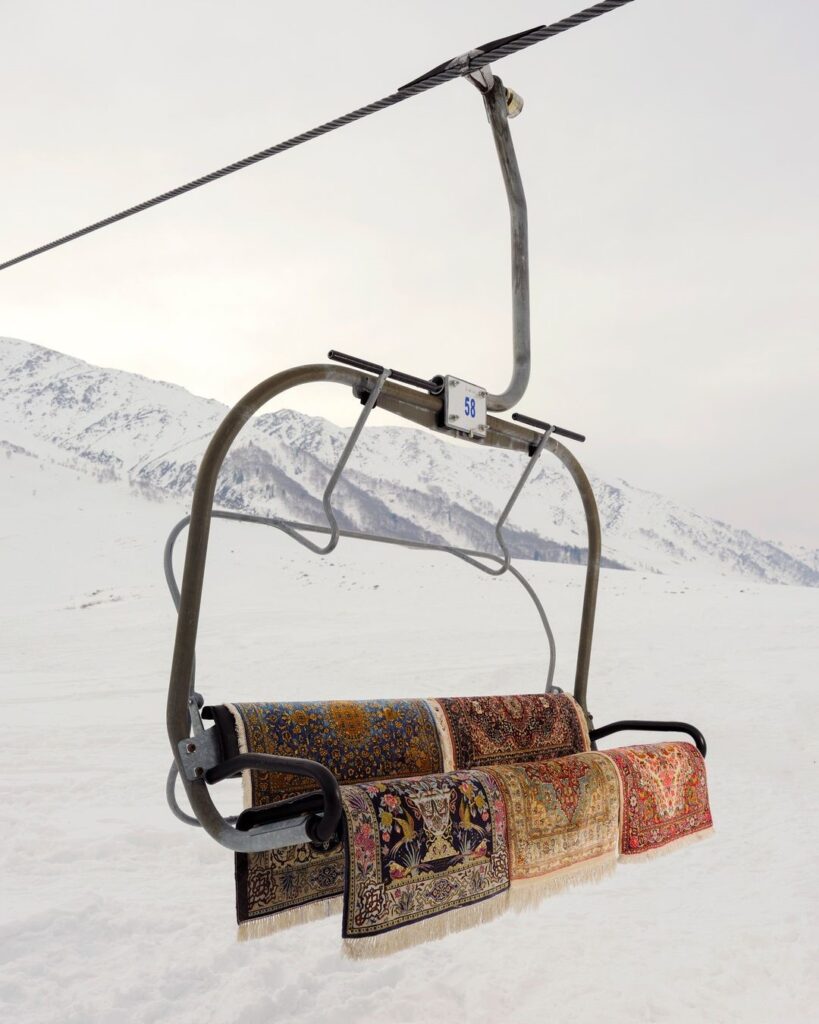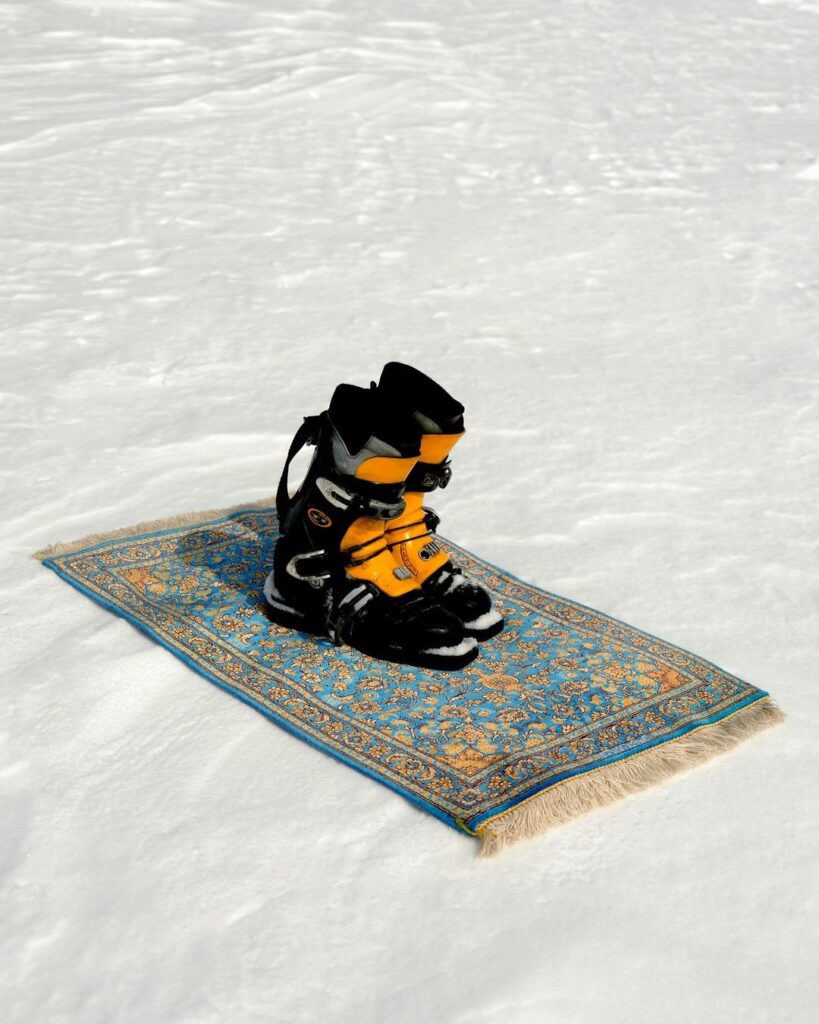March 15, 2024
The indian company, Jaipur Rugs has come under fire for its latest marketing campaign. The company recently conducted a photoshoot in indian-occupied Kashmir, titled “Jaipur in the Snow.” The campaign was led by the owners of Jaipur Rugs, Rutvi and Yogesh Chaudhary, art director Greg Foster, and photographer Ashish Shah.
In addition to shooting in occupied Kashmir, the collection was also titled the Gulmarg collection and featured “Kashmiri” carpets.
The carpets were staged to depict various situations. In one photo, they were laid out on top of a gondola as if riding it. In another, the carpet was placed under ski boots or between two ski sticks.



It is not the first time indian designers and companies have used Kashmiri designs, motifs and handicrafts for profit. Such examples are illustrated by Manish Malhotra’s Kashmir inspired autumn collection or Tjori’s winter collection featuring Kashmiri-style embroidery.

Jaipur Rugs’ use of Kashmiri carpets only highlights a growing settler colonial practice, whereby the settler society attempts to take ownership of the indigenous communities’ crafts and trade.
Additionally, the campaign photos clearly depict the carpets being used as a stand-in for humans. The Kashmiri backdrop automatically implies that the person the carpets represent is also Kashmiri.


Social media users were quick to point out the sinister appearance of the carpets tied to the trees, and how the scene bore an eerie resemblance to indian army jeeps which use Kashmiris as human shields.

The carpet tied up to the tree is a recreation of a method of torture and execution used on Kashmiri bodies. Given the ways in which Kashmiris have been completely immobilized and suppressed, this ad campaign reinforces india’s psychological war on Kashmir. It is similar to the many ways that india imprisons Kashmiris in their own homeland, through lockdowns, checkpoints, and surveillance. Kashmir and Kashmiris are quite literally held in bondage by the indian state, and its corporate entities.
By likening the Kashmiri body to the carpet, the campaign illustrates how fetishized and commodified Kashmiris have become in the colonial imagination.
In recent months, Zara also faced backlash for its insensitive ad campaign. The photos in the campaign resembled the images of corpses in white shrouds and coffins, and were released just as israel was committing its brutal genocide in Gaza.

In similar fashion, Jaipur Rugs also seized an opportunity by seeking inspiration from its fellow corporate entities. It created a campaign that would allow it to profit off the war crimes of settler societies and contribute towards the dehumanization of Kashmiris under occupation.
indian designers appropriating Kashmiri art is no longer shocking. It is an evident embodiment of the colonialist ideology that drives the indian occupation of Kashmir. The most egregious image, featuring a Kashmiri carpet tied to a tree, goes beyond mere cultural insensitivity. It is a visual echo of a specific tactic of racialized violence employed by the indian army and largely by the indian state, which has restrained Kashmiri civilians in this manner before subjecting them to torture and extrajudicial killing.
This designer’s work shows the ways in which the brutality of the occupation has been normalized and internalized across indian society. By casually referencing the indian army’s methods of torture, they engage in an act of “aesthetic violence” that is inseparable from the physical violence inflicted upon Kashmiri bodies by the armed forces. The carpet, which is a revered symbol of Kashmiri art is then transformed into an unsettling metaphor for the domination and immobilization of the Kashmiri people. What is important to note here is the fact that an indian cultural figure feels empowered to reproduce the visual language of torture and subjugation only speaks to the colonialist mindset that sanctions the dehumanization of Kashmiris. In tying up this carpet to the tree under the guise of “art”, the designer reeks of the indian state’s systematic strangulation of Kashmiri agency and self determination. They reflect the occupier’s belief that all aspects of Kashmiri life and culture are the property of the indian nation, to be controlled and exploited at will.
This and many other posts coming out of india, from these supposedly liberal designers, show us the link between the cultural violence of appropriation and the physical violence of the military occupation. It is an example of how the seemingly “apolitical actions” of indians actively perpetuate the domination that undergirds the repression of Kashmiri subjugation and their annihilation. By aestheticizing the torture tactics of the occupying forces, this designer has made a clear statement about the extent to which the sadistic logic of the colonizer has infected the indian psyche and reflects how indian designers actively perpetuate the mindset that sanctions genocide in Kashmir. Casually referencing torture methods used on Kashmiris, they do nothing but normalize unspeakable violence as an acceptable part of the occupier’s identity.
Stay in touch with Stand with Kashmir.
Stand With Kashmir (SWK) is a Kashmiri-driven independent, transnational, grassroots movement committed to standing in solidarity with the people of indian-occupied Kashmir in ending the indian occupation of their homeland and supporting the right to self-determination of the pre-partition state of Jammu and Kashmir. We want to hear from you. If you have general inquiries, suggestions, or concerns, please email us at info@standwithkashmir.org.


Leave a Reply